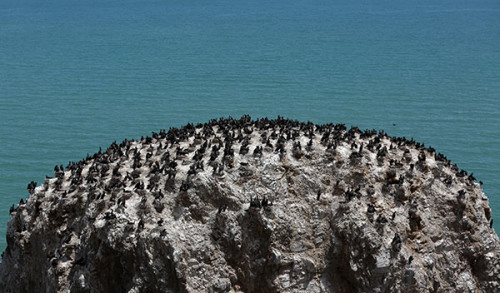
Flocks of cormorants nesting on Bird Island at the Qinghai Lake National Nature Reserve. (Photo by Wang Jing/China Daily)
Efforts to restore and protect the environment around China's largest inland lake are ensuring the safety of migratory bird species and local wildlife, and turning back the eco-clock to the 1980s heyday.
Almost every day, Li Yinghua walks through a window-lined sunken passage to his office, where banks of computer screens show real-time images of wild birds in the Qinghai Lake National Nature Reserve in Qinghai province.
"It's my job to monitor the screens," he said. "I observe the birds' activities, captured by video cameras installed at different points, to keep a record and watch for signs of abnormality."
The protection and study of migratory birds is one of the reserve's most important functions, and Li's office is on "Bird Island", which is actually a 1,500-meter-long peninsula on the lake's northwestern shore. The island's flat terrain and elevated location - the lake is more than 3,200 meters above sea level - make it an ideal nesting site for dozens of species of migratory birds, including a number of rarities. During peak breeding season, it's home to tens of thousands of birds and so densely dotted with nests full of eggs that it's also called "Egg Island".
"The place is like a maternity hospital for all kinds of birds during the breeding season, and I feel as though I'm the head nurse," Li said.
Although the 49-year-old Qinghai native has worked in the reserve for 30 years, he still remembers his early days as a middle school graduate from Xining, the provincial capital.
"I was a little disappointed with my first sight of my workplace," Li said. At the time, the region was desolate and uninhabited. The only accommodations were two small, plain houses, whose walls were discolored by the smoke from a coal fire. About 10 people crammed into each dormitory room.
With no markets nearby, the team often went without vegetables for two or three months. In winter, the temperature plummeted and the only freshwater spring froze, meaning team members would spend almost half a day breaking up ice and collecting drinking water. They lit stoves in the room to warm themselves at night.
The conditions were so harsh that Li considered leaving many times. "Who doesn't want a more comfortable working environment?" he asked.
His attitude changed as his knowledge of the birds grew. He still remembers his surprise at the birds' devotion to their eggs, and recalled how, after a heavy overnight snowfall, he was eager to check the condition of some brown-headed gulls' eggs, so he rushed to the lakeside early the next morning.
He couldn't see a single bird in the sky, which led him to assume that they had flown away. "When I finally reached the nests, I was amazed. I almost burst into tears. The brooding birds were sitting on top of their eggs, despite the heavy snow covering their backs."
Li realized that the gulls were afraid the snow would chill the eggs and kill the chicks inside, so they insulated them and kept them warm, not moving until the snow had melted.
Warning signs
Although the work is routine, Li understands its importance. He was among one of the first people to spot signs that heralded an outbreak of avian flu in 2005.
"I noticed that some of the bar-headed geese were vomiting fluids, and their feathers were fluffy. Some simply fell out of the sky," he said.
Samples were sent to institutes in Xining and Beijing for examination, and the birds were later found to be the first cases of a highly pathogenic strain of avian flu. In less than two weeks, more than 6,000 birds died, including nearly 1,000 bar-headed geese, one-tenth of the population. Other major species, such as brown-headed gulls and cormorants, were also affected. The birds were treated effectively, even though the cause of the disease was still unknown.


















































